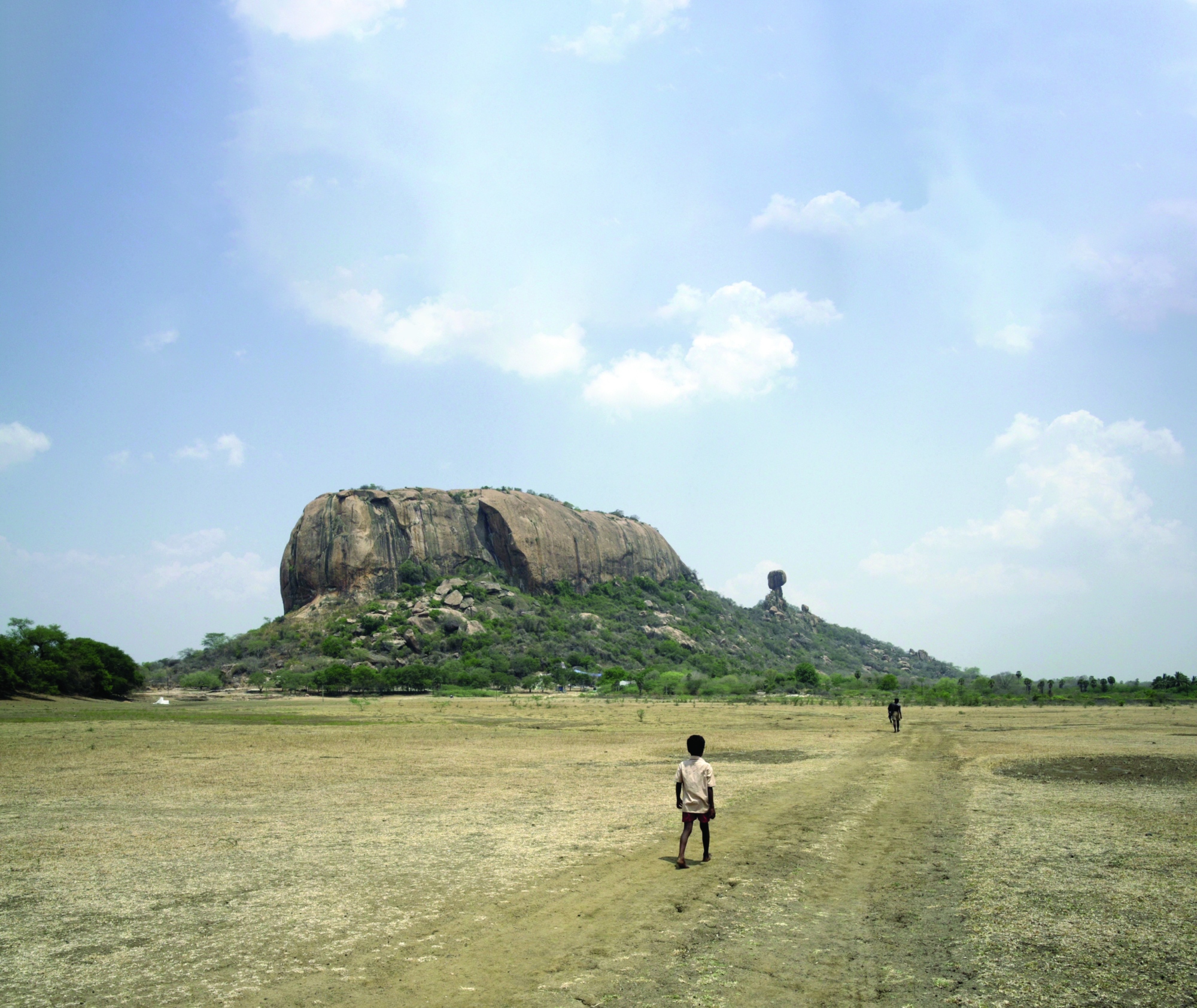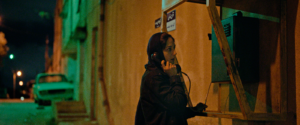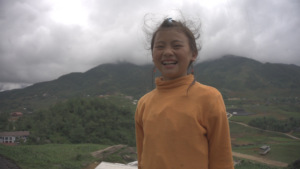There is a moment early on in Pebbles (PS Vinothraj, 2021) in which the furious movement that drives the film suddenly ceases. In its place, an image captured by a rare static camera fills the frame: a tableau of father and son waiting by the roadside. The formal composition of this ‘picture’ signals a departure from the realist film language that surrounds it. In the unnatural stillness of this moment, we glimpse a world where women are symbolically ‘removed’ from the social hierarchy and where men command the frame, both figuratively and metaphorically. First-time feature director Vinothraj uses the artificiality of this image to highlight the patriarchal gender politics that inform Pebbles.
The father is Ganapathy (Karuththadaiyaan) and the boy is Velu (Chellapandi). In the brief static image, they are seen waiting for a bus to continue their journey to find Ganapathy’s estranged wife, Shanthi, upon whom he is hell-bent on enacting retribution for leaving their abusive marriage and bringing his name into disrepute. The film’s brisk seventy-four-minute running time tracks their barefoot journey through the remote South Indian region of Tamil Nadu, the father driven by a relentless rage that takes on an almost operatic register. The rural landscape features prominently, anchoring the film in the specifics of place while at the same time suggesting a mythical, ‘otherworldly’ quality that becomes increasingly tangible as the frenzied journey progresses.
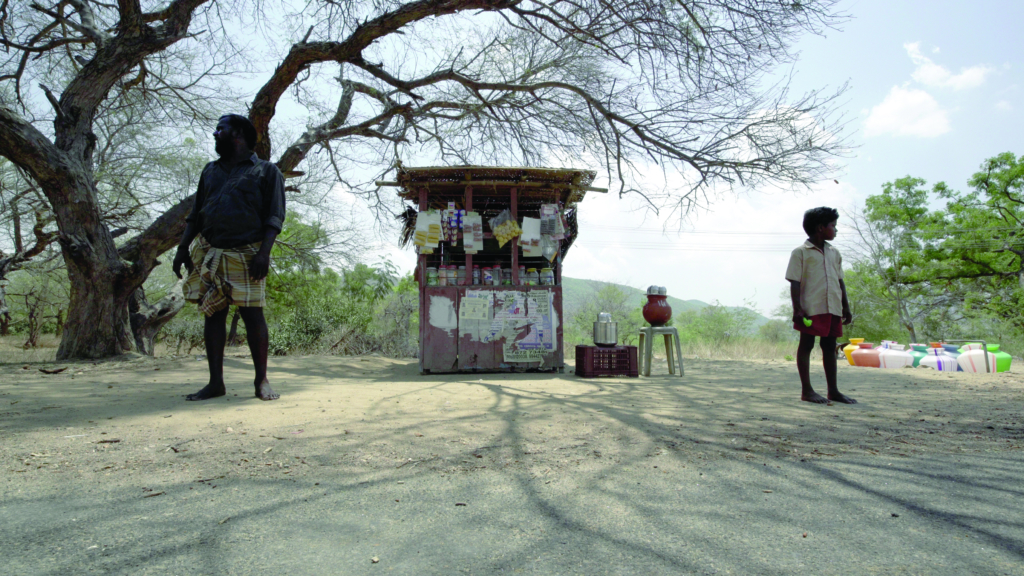
The setting works beautifully to underscore the existential tenor of the film – the rugged mountains are both majestic and cruelly indifferent to the human lives playing out at their feet. Their vast permanence is a physical counterpoint to the vulnerable Velu, who must follow his father’s furious trajectory across the barren landscape, bear witness to the cycle of poverty and violence, and accept an uncertain future. We can practically feel the strangling heat glancing off every surface, and are repeatedly invited to share the young boy’s perspective. In its privileging of a child’s viewpoint along with its focus on economic hardship, Pebbles recalls Indian auteur Satyajit Ray’s touchstone masterpiece Pather Panchali (1955).While both films share an interest in social realism, particularly in their treatments of poverty and the minute textures of life in their respective villages, the tone here is more threatening, the atmosphere charged with Ganapathy’s rage.
Speaking at the 2021 International Film Festival Rotterdam – where the film won the prestigious Tiger Award – Vinothraj expressed some of his primary intentions for the film (summarised in translation by the film’s executive producer and assistant director, Amudhavan Karuppiah):
The space plays a major role in the behaviour of a particular individual […] so, based on that, he [gave] this landscape a very important role in Pebbles […] He wanted to portray the life that he has seen – that he has grown up with – and the landscape that he has grown up around. He wanted to present that to a world cinema audience.[1]Amudhavan Karuppiah, in ‘Pebbles | Afterthoughts IFFR 2021’, YouTube, 6 February 2021, <https://www.youtube.com/watch?v=0ahFbLYB4kA>, accessed 12 November 2021.
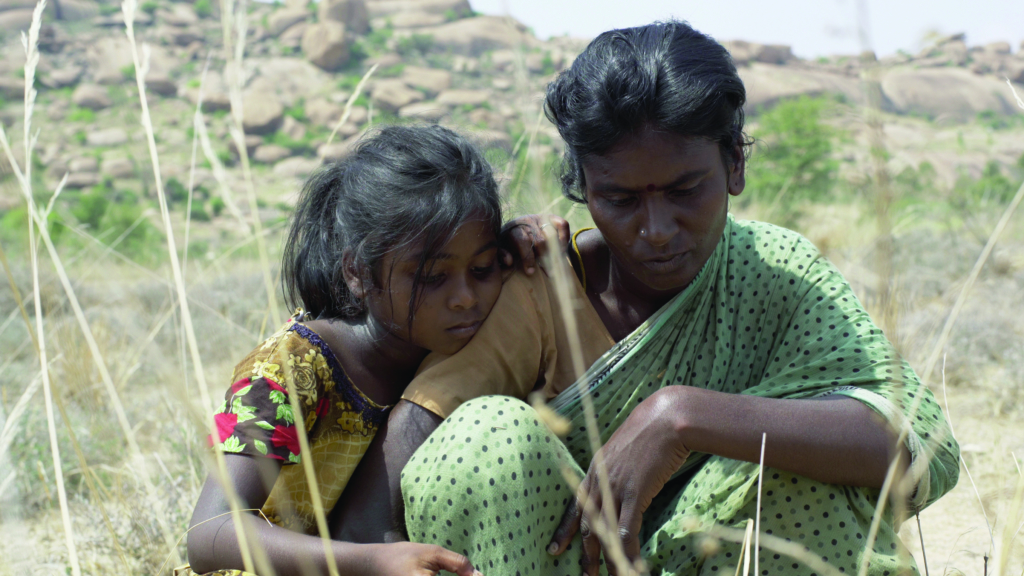
For Ganapathy, this natural landscape simply presents something else to be conquered, to be beaten into submission by his relentlessly pounding feet. In his desperate bid to forcefully ‘reclaim’ his wife, he navigates both physical and temporal space in an increasingly fraught manner; in these sequences, Vinothraj ratchets up the tension while effectively distilling the broader social context.
The perspective offered as we watch Ganapathy moving through space subtly contrasts with the brief interludes in which women appear in Pebbles. When Ganapathy approaches the village where he believes Shanthi is hiding, her female relatives come out to ward him off. A following shot tracks Ganapathy from behind, his sweat-drenched clothing a familiar focal point that we have become accustomed to sharing from Velu’s point of view. By mirroring the young boy’s perspective with the viewpoint of a woman, Vinothraj reinforces the crude power differential between the patriarchal oppressor and his victims. Just as Velu is positioned as vulnerable but intelligent and resistant to the violence of his father, the female relatives are similarly humanised. They attempt to disrupt Ganapathy’s brute force, along with the senseless, surging momentum that propels the narrative, by offering the promise of order restored and rage short-circuited by avenging furies: a meeting of force with force, irrational rage with righteous emotion. The women in the village match the forward impetus of Ganapathy, the camera tracking their forward trajectories as they too find power in movement. The women’s approach is captured front-on, their faces offering a welcome counterpoint to Ganapathy’s back-of-the-head framing. In this way, the power balance is momentarily visually undercut. Ganapathy is always ahead, out of reach, out of reason; his movement occludes space, symbolically cutting off any possibility of peaceful reconciliation or reasonable dialogue with his estranged wife. Conversely, the women move into space, their faces open, their movement inviting interaction and the possibility of some kind of communication.
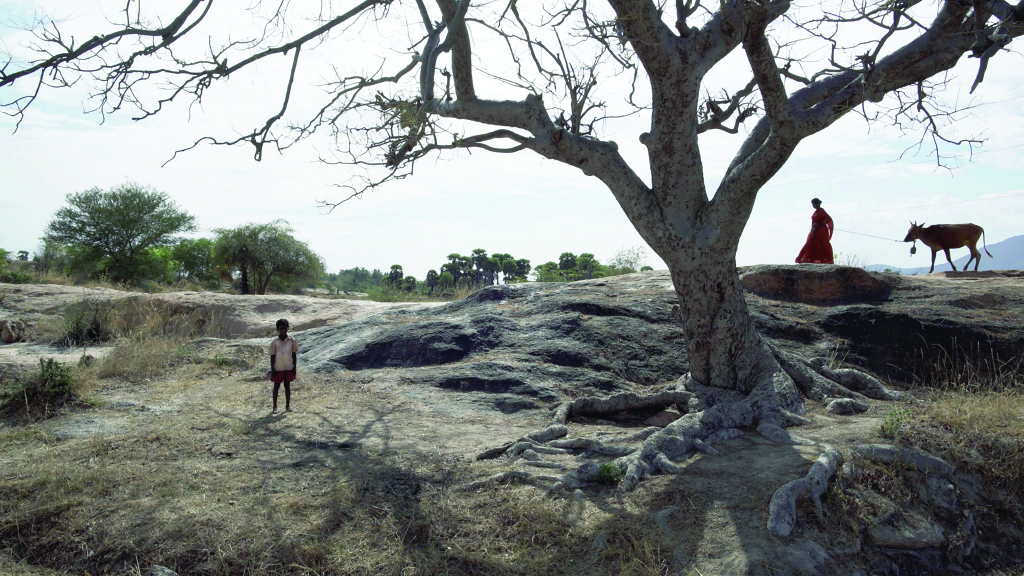
This contrast between the behaviour of men and women in the village is sadly illustrative of the state of play in Tamil Nadu, which holds the unenviable position of the state with the highest reported rates of domestic violence in India; indeed, in 2012, 42 per cent of domestic violence allegations in the country emerged from the region,[2]See R Vasundara, ‘Tamil Nadu Records Most No. of Domestic Violence Cases’, The Times of India, 3 December 2012, <https://timesofindia.indiatimes.com/city/chennai/tamil-nadu-records-most-no-of-domestic-violence-cases/articleshow/17457070.cms>, accessed 1 December 2021. which accounts for less than 6 per cent of the national population. Alcohol abuse and a dominant perception that women are the property of their husbands are commonly cited as primary factors for such high incidence.[3]See Anna Thomas, ‘Tamil Nadu Fights Back Against Domestic Abuse’, Union of Catholic Asian News, 1 July 2014, <https://www.ucanews.com/news/tamil-nadu-fights-back-against-domestic-abuse/71293>, accessed 1 December 2021. This situation is enunciated by Velu’s grandmother when she remarks, ‘All men have such failings. Us women, we need to adjust.’ Tamil Nadu’s extreme gender inequality is not even confined to the lived experience of its residents: an alarming disparity in the numbers of boys and girls in the region points to the practice of ‘daughter elimination’. As a 2008 study observed,
The sharp gap between the internationally expected pattern of infant mortality and the numbers observed in rural Tamil Nadu suggests post-birth interference (or negligence) and supports the idea that excessive female infant mortality may be driven by ‘social causes’, a euphemism for infanticide and neglect.[4]Sharada Srinivasan & Arjun Singh Bedi, ‘Daughter Elimination in Tamil Nadu, India: A Tale of Two Ratios’, Journal of Development Studies,vol. 44, no. 7, August 2008, available at <unfpa.org/sites/default/files/pub-pdf/UNFPA_Publication-39839.pdf>, accessed 12 November 2021.
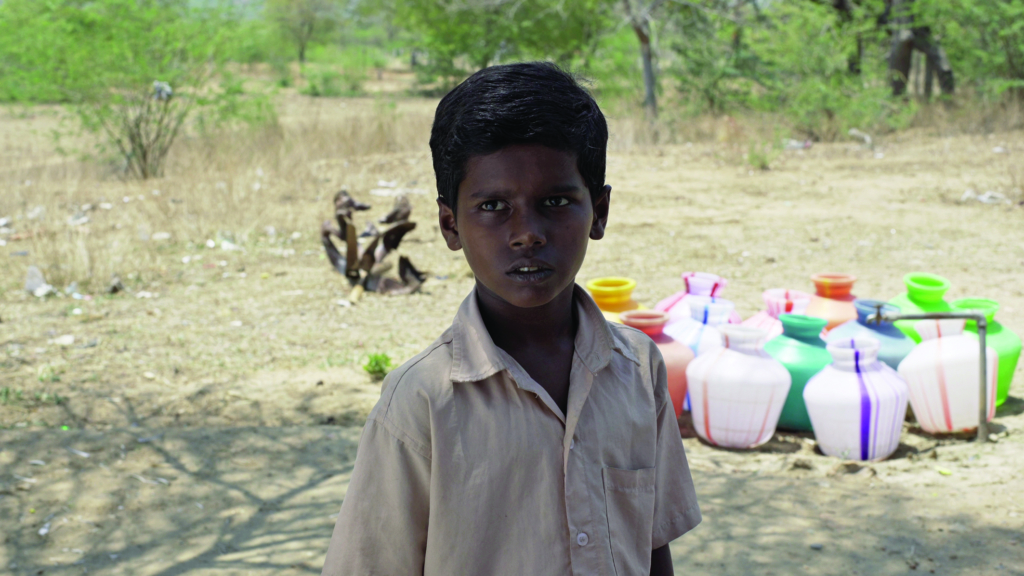
While the phenomenon of ‘daughter elimination’ is never directly alluded to in Pebbles, treatment of women and their place in the social hierarchy is clearly a focus. By homing in on the minutiae of the avenging husband / father-figure’s quest, the broader social context that might give rise to such a narrative is thrown into sharp relief. Vinothraj briefly defers to the forensic scrutiny of a documentary aesthetic when he shows us an elderly woman catching and then cooking a rat to feed a young girl; the role of women as protectors of children, and the limits of that protection due to poverty and the threat of male violence, is poignantly revealed in the scene. There is a very deliberate attempt to draw us into the lives of ‘ordinary’ people and make us more than passive observers. Karuppiah explains that Vinothraj enlisted a highly mobile camera because ‘he wanted the viewers also to be part of the film […] He wanted them to be a direct witness to the incidents happening.’[5]Karuppiah, in ‘Pebbles | Afterthoughts’, op. cit.
Pebbles’ cast of non-professionals – with the exception of Karuththadaiyaan, a trained stage actor and poet[6]Hansika Lohani Mehtani, ‘Koozhangal’, Platform, 29 October 2021, <https://www.platform-mag.com/film/koozhangal.html>, accessed 12 November 2021. – adds a heightened sense of realism to the characters’ interactions. This authenticity was important for the director, who describes in interview being determined to find a boy from a similar family background to Velu who had experienced the same kind of pain (in the end, over seventy children were auditioned for the part before Chellapandi was picked). Working with an amateur cast came with its own requirements; Vinothraj recalls spending a great deal of time on a meticulous rehearsal process, particularly in preparation for the extended takes that were needed so as not to interrupt Ganapathy’s rage.[7]‘Pebbles | Afterthoughts’, op. cit.
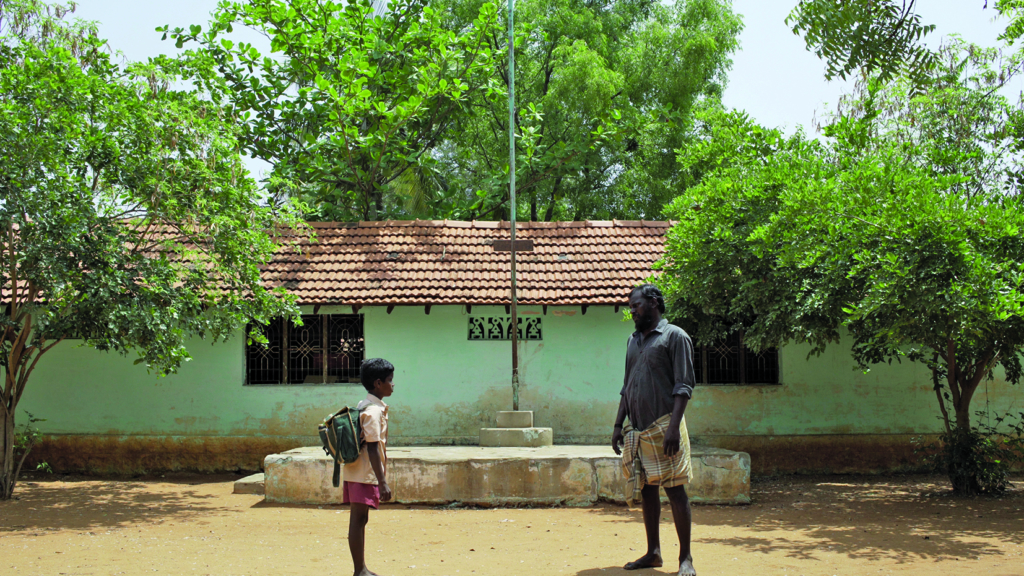
While the film’s setting operates as a site-specific anchor that helps to underscore issues of misogyny within Tamil Nadu, it also opens up a cinematic space to address more abstract, universal ideas about human relationships and the frailty and ultimate absurdity of life. Pebbles gradually begins to take on the power of a fable; its observational perspective, with its focus on actions and movement, seems to highlight the intransigence of the terrible bonds that entrap people. And it is in this way that the characters of Ganapathy, Velu and Shanthi assume a more primal significance that transcends the immediate narrative and speaks to an international audience. This is unusual for Tamil cinema, as International Film Festival Rotterdam programmer Stefan Borsos points out in interview with Vinothraj: ‘[In] the general Tamil film industry […] you have more commercial films and then these arthouse films, and [Pebbles], with its very peculiar visual approach, sits very much in between.’[8]Stefan Borsos, in ‘Pebbles | Afterthoughts’, ibid. It’s particularly interesting to note the more critical perspective on gender roles that Pebbles offers in comparison with most mainstream Tamil movies, which, cultural commentators Anusha Surendran and Janane Venkatraman argue, often reflect overtly patriarchal cultural norms:
Even a simple romantic proposal shown these days […] reiterates a misconception that the tolerance level of a woman is limitless and her self-respect is negligible. Love proposals are either the result of intense stalking […] or just a fleeting glance at a woman’s ethereal beauty.[9]Anusha Surendran & Janane Venkatraman, ‘Tamil Films Are Getting More Modern, and More Misogynistic’, The Hindu, 4 July 2017, <thehindu.com/thread/reflections/tamil-films-are-getting-more-and-more-misogynistic/article19209779.ece>, accessed 9 November 2021.
While the film’s setting operates as a site-specific anchor … it also opens up a cinematic space to address more abstract, universal ideas about human relationships and the frailty and ultimate absurdity of life.
Instead of reinforcing these misogynistic tropes around heterosexual relationships, Pebbles highlights the futility of a masculinity defined by aggression and control. Ganapathy’s misguided sense of ownership over his wife and child creates an irrational loop of closed circuitry; when the father and son end up back in their home village, the beginning and end point of their frenzied journey seems somehow both arbitrary and inevitable. Nothing has been gained; Ganapathy’s relationship with Shanthi has not been mended; all is as it was before.
Perhaps it’s unsurprising, then, that the film’s last moments are reserved for the women of Ganapathy and Velu’s village. The frantic forward movement is finally countered with a welcome respite of stillness as the mothers and wives wait patiently for their turn to draw water from the village well. This moment of stillness recalls the earlier father–son tableau; that artificial image is now formally rebuked by the restorative power of an image predicated on authenticity. Shanthi is eventually ‘located’ here among the waiting women – it is not Ganapathy but the objective, roving gaze of Vinothraj’s camera that finds her. Here, Vinothraj reverts to a documentary style in order to capture the languid action of an elderly woman drawing water from the well. The village women wait calmly, respectfully, as if they have all the time in the world.
Endnotes
| 1 | Amudhavan Karuppiah, in ‘Pebbles | Afterthoughts IFFR 2021’, YouTube, 6 February 2021, <https://www.youtube.com/watch?v=0ahFbLYB4kA>, accessed 12 November 2021. |
|---|---|
| 2 | See R Vasundara, ‘Tamil Nadu Records Most No. of Domestic Violence Cases’, The Times of India, 3 December 2012, <https://timesofindia.indiatimes.com/city/chennai/tamil-nadu-records-most-no-of-domestic-violence-cases/articleshow/17457070.cms>, accessed 1 December 2021. |
| 3 | See Anna Thomas, ‘Tamil Nadu Fights Back Against Domestic Abuse’, Union of Catholic Asian News, 1 July 2014, <https://www.ucanews.com/news/tamil-nadu-fights-back-against-domestic-abuse/71293>, accessed 1 December 2021. |
| 4 | Sharada Srinivasan & Arjun Singh Bedi, ‘Daughter Elimination in Tamil Nadu, India: A Tale of Two Ratios’, Journal of Development Studies,vol. 44, no. 7, August 2008, available at <unfpa.org/sites/default/files/pub-pdf/UNFPA_Publication-39839.pdf>, accessed 12 November 2021. |
| 5 | Karuppiah, in ‘Pebbles | Afterthoughts’, op. cit. |
| 6 | Hansika Lohani Mehtani, ‘Koozhangal’, Platform, 29 October 2021, <https://www.platform-mag.com/film/koozhangal.html>, accessed 12 November 2021. |
| 7 | ‘Pebbles | Afterthoughts’, op. cit. |
| 8 | Stefan Borsos, in ‘Pebbles | Afterthoughts’, ibid. |
| 9 | Anusha Surendran & Janane Venkatraman, ‘Tamil Films Are Getting More Modern, and More Misogynistic’, The Hindu, 4 July 2017, <thehindu.com/thread/reflections/tamil-films-are-getting-more-and-more-misogynistic/article19209779.ece>, accessed 9 November 2021. |
